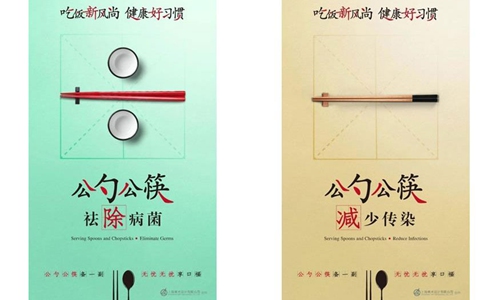HOME >> ARTS
Will COVID-19 finally change China’s communal eating culture?
By Global Times-Jiemian Source:Global Times Published: 2020/3/1 22:34:56

Posters released by Shanghai authority on February 23 to encourage people to use gongkuai Photo: Shanghai Fabu WeChat account
Family meals at home or at restaurants have traditionally involved everyone sitting around a single table picking and choosing from several dishes that are shared together. However, with the COVID-19 outbreak, many restaurants and dining establishments in China have suspended operations and the public has been advised to use a serving spoon or serving chopsticks to serve themselves food while eating together with others instead of picking food off serving plates with their own chopsticks.
These changes to traditional habits have sparked questions about whether the epidemic will end up changing the country's time-honored communal eating tradition that has been so closely connected to social interaction?
Unlike Western countries, in most traditional Chinese dining situations, dishes are shared communally. It often comes as a surprise to Chinese people when they see a group of foreigners order several dishes of kung pao chicken for each individual in a Chinese restaurant. As a dominant aspect of Chinese culture, people enjoy eating together. While it is not considered rude to request gongkuai, a pair of serving chopsticks specifically used to choose food from communal dishes, many people still use sikuai, their personal chopsticks, when eating with others.
Amid the COVID-19 outbreak, local authorities in Shanghai proposed on February 23 for people to use gongkuai. "Reduce infections" and "eliminate germs" were the slogans printed on posters released as part of public education efforts concerning the proposal. The next day, 100 restaurants in Shanghai announced they would be providing gongkuai with each dish and allow a single customer to have an entire table to him or herself when the situation permits.
Similar proposals and regulations regarding the use of gongkuai had appeared during the 2003 outbreak of SARS (severe acute respiratory syndrome), but its popularity faded as the epidemic ended. It appears having Chinese people change their long-time habit of sharing meals together and not using gongkuai was no easy task. However, history shows that it is not impossible. Back in the ancient times, Chinese people did have a tradition called fencan, which was enjoying individual servings of dishes and using gongkuai. The modern concept of gongshi, or communal eating didn't actually appear until the Song Dynasty (960-1279).
Dining and social hierarchy
Before the Zhou Dynasty (1046 BC-256 BC), due to harsh living conditions and an insufficiency of food, meals were divided into servings for individuals equally out of fairness. With the establishment of li during that dynasty, a ritual system that embodied the expression and ideology of social hierarchy, the tradition of fencan officially began. Strict rules were applied about different tableware for people of different social status.
Evidence of such dining manners can be seen in the description of the Banquet at Hongmen in the Records of the Grand Historian, a history book of ancient China complied about 2,000 years ago. In the record of the historical event that took place in 206 BC, attendees were described as sitting on the floor, each at their own tables. Likewise, in the Night Revel of Han Xizai, a painted scroll depicting a historical scene from Tang Dynasty (618-907) Minister Han Xizai's evening banquet, the minister and a valuable guest each have their own table with more food, in contrast to a guest sitting across from them at a single table with fewer dishes.
Yet with the introduction of new types of furniture, people gradually changed seating arrangements and the types of tableware that was used. When teahouses, taverns and public entertainment spaces became popular during the Song Dynasty, the practice of communal eating started to catch on.
Communal eating vs epidemics
While in recent times, people in China have grown accustomed to communal eating and consider it a way of showing closeness and intimacy, the concept of fencan has been repeatedly advocated with each arrival of some new epidemic.
Doctor Wu Lien-teh, who was in charge of fighting the plague that hit China in 1910, had proposed such a practice to avoiding cross-infection.
"Change communal eating," an article published by People's Daily in May 1983, also addressed the issue in response to the spread of hepatitis across the country during the 1980s.
"It's a bad habit that needs to be gotten rid of," said Guo Jie, an official at the Minister of Health at the time. This voice grew stronger when it came to 2003, the SARS outbreak.
"The SARS outbreak made the significance of fencan evident to us again. As public awareness of disease prevention continues to be raised, fencan is sure to be accepted by the public," wrote experts from the Epidemic Prevention and Control Center in Jilin Province, Northeast China, in an academic article published in 2004.
It's hard to tell how much fencan has been accepted by the public and how it has been practiced in people's daily lives when they are eating at home with family. Hopefully, something good can come out of this current COVID-2019 epidemic and people will make even more changes for the sake of their own health and that of others.
Posted in: CULTURE & LEISURE